November 25, 2005
Air Date: November 25, 2005
FULL SHOW
SEGMENTS
New Orleans Mold
View the page for this story
According to the Natural Resources Defense Council, mold spore levels in many parts of New Orleans are two to four times normal levels. Despite government safety warnings, residents are being allowed back into parts of the city with unsafe mold contamination counts. Many locals are complaining of runny noses, sore throats and a persistent cough. Host Steve Curwood talks with Dr. Gina Solomon, senior scientist for NRDC, which conducted independent mold measurements, and Dr. Dick Jackson, former head of the Center for Environmental Health at the Centers for Disease Control. (06:30)
Climate Change Talks
/ Jeff YoungView the page for this story
Nations already signed on to the Kyoto Protocol would like the upcoming round of climate talks in Montreal to lead to new cuts in greenhouse gas emissions. But the world’s largest carbon polluter -- the United States -- has a different agenda. Living on Earth’s Jeff Young reports from Washington. (05:30)
Preserving the Magic of Madagascar
View the page for this story
PART 1: This week we present a special two-
part report on Madagascar. This island nation off the southeast coast of Africa possesses the most numerous and rarest of animal and plant species on the planet. Producer Daniel Grossman visited the island to assess the conservation efforts underway to preserve Madagascar's unique ecosystem which is under intense pressure from deforestation.
PART 2: Our story on efforts to protect
Madagascar's rich flora and fauna continues with a look at how scientists and farmers are working to develop new agricultural methods that allow farmers to make a living without cutting down any more of the island's forests. Daniel Grossman reports. (28:30)
Listener Letters
View the page for this story
We hear from our listeners about recent Living on Earth stories. (02:15)
2005 Best Reading
View the page for this story
From stories about tracing the steps of caribou to tracking the path of garbage, Outside magazine's Bruce Barcott found many environmental books to like this year. He gives us his list of favorites. (03:15)
This week's EarthEar selection
listen /
download
Nightfall in Madagascar’s lush rainforest.
Show Credits and Funders
Show Transcript
HOST: Steve Curwood
GUESTS: Gina Solomon, Richard Jackson
REPORTERS: Jeff Young, Daniel Grossman
COMMENTATOR: Bruce Barcott
[THEME MUSIC]
CURWOOD: From NPR, this is Living on Earth.
[THEME MUSIC]
CURWOOD: I’m Steve Curwood. As people are getting let back into the flood-ravaged neighborhoods of New Orleans, many are having respiratory problems. A private medical team has identified the likely culprit.
SOLOMON: Having spent several weeks on the ground in New Orleans and talked with a lot of people and looked at the environment, the mold is my number one suspect at this time for the Katrina cough.
CURWOOD: So far, government officials are not testing for mold, but a former senior public health officer says we delay action at our peril.
JACKSON: This may seem small, it may seem invisible right now, but over time we’ll realize, Oh my god, we should have made sure that everyone had the proper protections, the masks, and the rest.
CURWOOD: Also, from landfills, to deserts, to glaciers, a look at this year’s best books on the environment. We'll have those stories and more, this week on Living on Earth. Stick around.
[NPR NEWSCAST: Boards of Canada “Zoetrope” from ‘In A Beautiful Place Out in the Country’ (Warp Records – 2000)]
[THEME MUSIC]
ANNOUNCER: Support for Living on Earth comes from the National Science Foundation and Stonyfield Farm.
New Orleans Mold
CURWOOD: From the Jennifer and Ted Stanley Studios in Somerville, Massachusetts, this is Living on Earth. I'm Steve Curwood.
Many people returning to New Orleans have reported sore throats, runny noses, and a nagging hack that has been coined the "Katrina cough.” Some experts are linking the cough to extremely high levels of mold coming from the soggy wreckage left behind by the extensive flooding of the city. With city officials authorizing return to some areas the government is recommending that people use inexpensive face masks to keep from inhaling mold spores. But so far there have been no official counts of mold levels.
Joining me is Physician Gina Solomon, a senior scientist for the Natural Resources Defense Council, who conducted her own tests of mold in New Orleans in October. Also on the line is Dr. Richard Jackson, former head of the Center for Environmental Health at the Centers for Disease Control. Dr. Solomon, from what you saw on the ground in New Orleans, just how serious is the mold contamination?
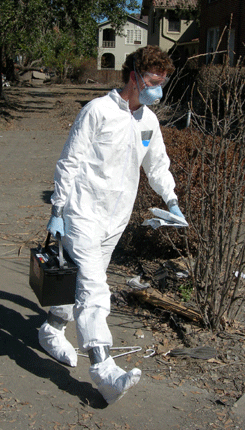
Dr. Gina Solomon suited up in protective gear when she conducted mold testing in New Orleans. (Photo courtesy of NRDC)
CURWOOD: Dr. Jackson, what’s the problem with mold spores? What can they do to people?
JACKSON: These are complex microorganisms that your body develops immunity to, and that’s why you have allergies and begin sneezing and your eyes burn and the rest. Certain individuals can actually have direct toxic effects from the mold. And, in fact, if you have impaired immunity, the mold can begin to grow in your body and you have an inability to eradicate it. So simply because we can’t see it doesn’t mean we should ignore it and pay no attention. This can make people quite ill, it can set off asthma attacks. People can die from an asthma attack.
You really have to think about who are the people being exposed. One is a healthy person in a work setting – is going to need protective equipment. We are going to have to clean up those areas. Two is that folks that are at some immune or other kind of concern, one is going to have to think about how you also protect them. And actually have gradations of how they go into those areas.
CURWOOD: So the local authorities in New Orleans have said, Hey, it’s okay to go back into these areas. They are urging people to wear protective gear. Does this make sense from your perspective, Dr. Solomon?
SOLOMON: The zip codes that have been reopened for habitation, unfortunately, include some of the ones that had the highest mold levels in our study. That’s probably because a lot of that mold is being disturbed; a lot of people are ripping out drywall and sheet rock and the mold is flying around in the air. It, in my mind, would be wiser to wait until the dust settles, quite literally, and the mold spores settle, before having people back in that community.
CURWOOD: Dr. Jackson, what would be your advice as to the re-population of these areas?
JACKSON: I’m a little reluctant to say one size fits all. I can easily imagine a family that’s been living in a motel room, and the children have been going to a distant school that they don’t know. People are lonely for their family and their friends. There are real costs for those families as well. So folks are facing decisions that at some level are pretty personal, and I think the important thing is to get them the information they need. Here are what the exposures are; here are the ways you can protect yourself. But I’m reluctant to simply keep people out who have been displaced now for weeks and weeks and weeks because of measurements we’ve taken. That said, it is absolutely appropriate to be very concerned about these exposures.
CURWOOD: From your experience as a state and federal regulator, what responsibility do you think that the state or the federal government should have, in terms of measuring these mold levels in New Orleans?
JACKSON: The proper role of a place like CDC is to offer guidance and recommendations – here is how you can reduce levels, here is how you can protect yourself – and controls and protections both for workers and for the public.
CURWOOD: Why do you think the EPA or another government agency hasn’t stepped in to test for this mold? Why is a private organization like the Natural Resources Defense Council the source of information at this point?
JACKSON: I can’t speculate. I suspect that they’re feeling so overwhelmed with threats that are perfectly visible that these that are less visible, one is slower to begin to grasp and grapple with these.
CURWOOD: How does one dispose of moldy materials safely to not aggravate the health situation, Dr. Solomon?
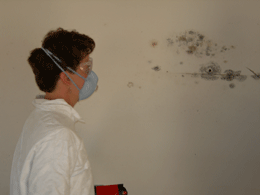
Dr. Gina Solomon looks at mold on a house wall in New Orleans. (Photo courtesy of NRDC)
CURWOOD: If authorities were to come to you and say, Look, what do we do with all this moldy stuff? What would be the safe way to get rid of this so it doesn’t aggravate public health any further? Dr. Jackson, what would you tell them?
JACKSON: You know, I think after disasters one has this frantic desire to take care of what needs to be taken care of. I’ve seen over and over again that one of the major effects is really the emotional trauma the communities go through. And cleanup becomes almost its own – people become obsessed with the cleanup and oftentimes don’t regard or worry enough about their own protection. And I think the levels that have been laid out here really point out that, you know, this may seem small, it may seem invisible right now; over time we’ll realize, Oh my God, we should have made sure that everyone had the proper protections, the masks and the rest.
CURWOOD: I want to thank you both for taking this time. Dr. Richard Jackson is a professor at the School of Public Health at the University of California at Berkeley, and Dr. Gina Solomon is a senior scientist for the NRDC and clinical assistant professor at the University of California at San Francisco Medical School. Thank you both.
SOLOMON: Thank you.
JACKSON: Thank you, this is an important show.
Related link:
NRDC New Orleans Test Results
Climate Change Talks
CURWOOD: Climate negotiators from around the world are heading to Canada for a key round of talks on how to halt global warming. The meeting in Montreal could set the course for the next set of reductions in greenhouse gas emissions. Industrialized nations who have already agreed to cut emissions want major developing countries like China, Brazil and India to sign on to mandatory limits under the next phase of the Kyoto Protocol. But without participation by the world’s largest carbon polluter – the United States – hopes for getting the big developing countries aboard are slim. Living on Earth’s Jeff Young reports from Washington.
YOUNG: The first international agreement to reduce greenhouse gases, the Kyoto Protocol, just took effect this year. But the countries involved are already looking ahead to their next step – agreements on further cuts beyond the year 2012. Alden Meyer of the Union of Concerned Scientists says it’s important that the process start now.
MEYER: Do we implement the Kyoto Protocol and then go beyond it? Do we set the kind of binding emissions reductions that we know, from the science, are going to be needed to really get a handle on this problem in the next several decades? Or do basically we stop dead in our tracks? That’s really the stakes for the Montreal negotiations.
YOUNG: Meyer says part of the challenge is to find a fair way to include the booming economies of China, India and Brazil, which will soon join the developed nations as the world’s major carbon emitters. That alone would be hard enough. But there’s also the matter of that other major economy not yet in Kyoto – the United States.
MEYER: It’s clear the Bush administration would like to try to strangle the Kyoto protocol in its crib and prevent a conversation from even starting.
YOUNG: The Bush administration remains hostile to any legally binding cap on carbon emissions and works to block other countries from taking them on. Debbie Reed worked with the White House climate change task force in the Clinton administration. She’s now with the National Environmental Trust, a Washington advocacy group. In the U.S. the Bush administration argues that it can’t be part of any pact like Kyoto until developing countries like China and India take part. But Reed says there’s a different message abroad.
REED: At the negotiations what they have said even publicly is – to India and China – is that you should not make commitments because it will harm your economy. So they play this duplicitous game.
YOUNG: The Administration’s climate negotiators in the State Department declined repeated requests for comment. State department officials recently told a Senate committee about the administration’s approach to climate change. It focuses on voluntary reductions in emissions and sharing technology with developing countries.
The emphasis is on emerging technology that could capture the carbon from coal burning power plants. In Congress, a few still question the scientific evidence of global warming. Oklahoma Republican Senator James Inhofe says he’d like to see the Montreal talks bring a thorough review of the international scientific panel on climate change.
INHOFE: The more I have delved into the issue, the more convinced I am that science is being co-opted by those who care more about peddling fear of doom and gloom to further their own broad agendas than they do about scientific integrity.
YOUNG: But Inhofe’s view is now at the fringe of Senate opinion. This summer, 54 senators voted for a resolution recognizing the science of climate change and calling for some form of mandatory carbon cuts. And a growing number of Senators says it’s time for the US to get back into international climate negotiations.
BIDEN: Everyone here today knows the international climate change negotiations are broken.
YOUNG: Delaware’s Joe Biden is the ranking Democrat on the Senate’s Foreign Relations Committee. He and committee chair, Republican Richard Lugar of Indiana, introduced a resolution this month calling for the US to negotiate a fair international commitment on climate change. Lugar says it’s a message to the rest of the world that not everyone in the US government agrees with the Bush administration’s stance.
LUGAR: Because it commits us to influence at least not only our countrymen but others outside this country who might wonder, is anybody listening, does anybody care? And we’re saying, we do.
YOUNG: Lugar and Biden spoke at an event sponsored by the Pew Center on Global Climate Change, a Washington think tank that thinks it has a possible path for engaging countries like China and India. The Pew Center spent nearly two years talking with industry and government representatives from 20 nations and came up with a sort of mix and match plan of energy policies for different countries and emissions targets for different industries.
The Pew Center’s Eileen Claussen says the plan is flexible enough to at least bring developing nations into talks. As for the US, Claussen talks about waiting for the next elections and the next occupant of the White House.
CLAUSSEN: No matter which party ends up there I think we’re going to have a slightly more constructive attitude on this. And if some of the groundwork has been done and some of the thinking has progressed, and we have some involvement, I think we might have something ready to go by the time 2012 comes around. I mean, I don’t know any other way to do it.
YOUNG: Claussen and others will take their long-term strategies to the Montreal talks, an event where the stakes may be high but the expectations are not. For Living on Earth, I’m Jeff Young in Washington.
[MUSIC: Tuu “Fetish” from ‘One Thousand Years’ (Waveform – 2001)]
CURWOOD: Coming up: preserving the magic of Madagascar. Keep listening to Living on Earth.
[MUSIC: Live Griot Music from Madagascar recorded by Daniel Grossman (2004)]
[JUNGLE SOUNDS; INSECTS BUZZING; BIRDS CHIRPING]
Preserving the Magic of Madagascar

(Photo: Daniel Grossman)
CURWOOD: It’s Living on Earth. I’m Steve Curwood. The island nation of Madagascar, off the south east coast of Africa, is famous for two things: It is home to an astounding range of plants and animals found nowhere else in the world. And it has become famous for the rapid degradation of its habitats. Now, even though Madagascar has already lost most of its original forest cover, it is still rich in biological diversity, and preserving what’s left has become a top priority for international conservation organizations. Dan Grossman has our report.
[RAINFOREST SOUNDS CONTINUE]
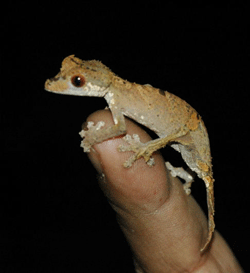
A gecko. (Photo: Daniel Grossman)
According to Stuart Pim, a tropical forest specialist at Duke University, primeval rain forests occupy only about five percent of Earth’s land, yet contain around half of all terrestrial species. They’re being cut today at a furious rate. Every second about one acre of tropical forest is being cleared for grazing, agriculture, or other purposes. Every month a combined area of rainforest about the size of Connecticut is cleared somewhere.
It’s easy to imagine the major villains as short-sighted ranchers, corrupt politicians and unscrupulous timber companies. But in Madagascar, most enemies of the forest are of a different breed. In a country where a third of the people are undernourished, the forest’s foes are the poorest of the poor. Sometimes on the verge of starvation, they’re just scraping by.
Primate researcher Alison Jolly writes about one such man in her book “A World Like Our Own: Man and Nature in Madagascar.” She found him carrying his indispensable coup-coup ax.
JOLLY (READING): With a coup-coup over his shoulder, and a bridled dog behind him, Jean d’Armand strode up the mountain path as though he wore Paul Bunyan’s boots instead of cracked calluses upon his heels. Jean is the rainforest’s executioner. He’s the last frontiersman in a world that has no wilderness to spare. In defiance of Malagash law, and all principals of conservation, he still tackles the virgin forest with his coup-coup. He brings down rosewood, towering white rami trees, and hinsi, the cabinet-maker’s prize, with its crimson heart. These rainforest hardwoods are too dense even to float and must rot for one or two years before Jean can burn their trunks to enlarge his little homestead clearing.
GROSSMAN: These trees release so much water vapor through their leaves, they alter the weather. In their great green canopies live whole communities of plants and animals, including voluptuous orchids, blankets of moss, vines and tree-dwelling rodents. For the forest, such trees are the cornerstone of life. To a forest executioner with a family to feed, they’re a stack of valuable lumber.
A single hole in the canopy severs threads in the living fabric of the forest, and takes years to heal. As more trees are cut, the fabric unravels irreversibly. That’s what’s happening to Madagascar’s virgin, or primary, forest. Only about 10 percent of it remains intact. Biologists and conservationists around the world are watching Madagascar’s forests anxiously, concerned about the fate of its distinctive wildlife. Alison Jolly says Madagascar’s forests may look like any other at first glance, but up close they’re very different.
JOLLY: Madagascar’s a kind of science fiction world. You know, every science fiction writer tries the tale of alternate worlds. What would happen if time broke its banks and came to the present down a different channel? Well, Madagascar is just like that. Eighty or ninety percent of all its plants and animals are unique. The species are unique to Madagascar. You go there and you look and you say, “Oh, that’s a nut hatch.” Uh-uh. It’s a coral-billed vanga. It’s an animal, a bird whose whole family only lives on Madagascar. You look and you say, “Oh, that’s Arizona. That’s a cactus.” Oops. No. It isn’t quite right. It’s 20 foot tall and it sticks up like a giant hand against the sky and it has thorns all down it. But it’s got wood inside. It isn’t a cactus.
GROSSMAN: Perhaps the most famous of Madagascar’s animals is a primitive group of primates called lemurs. Dr Jolly, who’s a lemur expert, says they don’t even look like anything elsewhere.
JOLLY: You look at lemurs and you think, "Wait a minute. That’s not a cat, and that’s not a squirrel and it’s got hands with fingernails and big round eyes that look right at you. So what is it? And they live in societies that are like ours but with real twists, like complete female dominance".
GROSSMAN: Madagascar is special not just because most of what lives there lives only there. It’s also because of the bewildering variety of what’s there. Take plants. There are 12-16 thousand species of plants native to Madagascar.
MITTERMEIER: By comparison, all of North America, north of Mexico, has about 18,000.
GROSSMAN: Primate expert Russell Mittermeier is president of Conservation International, one of the world’s leading non-governmental advocates for tropical forest protection. He says the island is unusually rich in many animals, too, including snakes and chameleons, among the reptiles.
MITTERMEIER: The estimates run from about 340 to as many as 380 species of reptiles in this island that is a little bit larger than California and a little smaller than Texas. In all of the United States north of Mexico you’ve got about 300 reptile species. It looks like we are going to go as high as 300 amphibian species in Madagascar. This is more than all of the United States and Canada put together.
GROSSMAN: But Madagascar’s phenomenal fauna is not what it used to be.
[SOUND OF DIG SITE; SHOVELS SCRAPING; “Where’d the brush go?”]
GROSSMAN: Biologist David Burney squats on the balls of his feet on the floor of a pit the size and shape of a grave.
[BURNEY TALKING TO COLLEAGUES AT DIG SITE; “It’s not tortoise.”]
GROSSMAN: Hands caked in mud, face bronzed by the relentless sun, Burney breaks the compacted soil with a smack of a geologist’s pointed hammer.
BURNEY: The largest hole that I’ve dug like this, with the occasional help of a small pick but mostly just with my bare hands, so I don’t break up stuff and scratch it, is about 60 feet long and 20 feet wide and 20 feet deep. It’s on the island of Kawaii. I think we’ve probably, in that one site, done this kind of stuff to now, total of about 200 cubic meters. So, you know, I must like doing this. I don’t’ seem to mind it anyway.
GROSSMAN: For more than two decades, Burney has been researching what Madagascar was like before it was peopled. He believes learning the fate of wildlife in the past will help to anticipate – or, perhaps, to shape – the fortunes of wildlife in the future. Madagascar’s original settlers, probably Indonesian people sailing outrigger canoes, arrived here about 2,000 years ago. Burney says they must have been astounded by the wildlife they discovered, including the largest bird that ever lived, the elephant bird.
BURNEY: Elephant birds were probably up to 1,000 pounds, 500 kilos, and stood ten feet tall. Over three meters. Try to imagine an ostrich multiplied by three or four.
GROSSMAN: This colossal flightless fowl was among dozens of oversized creatures, known as megafauna, unique to Madagascar. The remarkable menagerie included a gorilla-size lemur, a coffee table-size tortoise, and a cow-size, hippopotamus-like creature.
BURNEY: So we had a really diverse landscape here. A lot of different kinds of mammals. A lot of diversity of primates. Not like any place else on Earth. And now it seems to all be gone.
GROSSMAN: Today these bizarre giants are extinct. Aside from the crocodile, the largest native animal now is not much bigger than an overfed pussycat. Burney says humans almost certainly starred in this murder mystery, though the “murder weapon” and the exact scene of the crime are unknown. Was it hunting in marshes? Logging in forests? Burning in savannas? Whatever it was that humans did to the megafauna, the scientist says his gut tells him the purge is not over yet.
BURNEY: My suspicion is that Madagascar is still in an extinction event. It’s simply affecting now smaller animals. And perhaps eventually even some plants.
GROSSMAN: Burney believes the biggest breeds went first because large animals are generally more affected by forest clearing, hunting, and the like, than small ones. They need more territory and they generally breed—and thus recover from disturbance—more slowly. Hunters find them easier to spot and more worthwhile to catch. Today, Madagascar’s once-continuous forest canopy has turned into an archipelago of tiny embattled wildlife strongholds in a sea of farmland and pastures. Now even the smallest creatures are at risk.
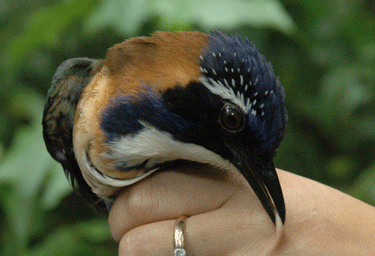
The pitta-like ground roller dwells almost exclusively on the forest floor. (Photo: Daniel Grossman)
FREUDENBERGER: What we see today is the last remaining sliver of the vast primary forest that used to cover Madagascar.
GROSSMAN: Agriculture expert Mark Freudenberger says Madagascar’s rural poor are trapped in an ill-fated cycle of forest destruction. In much of this country, the only new land available for farming is primary forest. So when farmland becomes exhausted and unproductive, and when new families need new plots, people are forced to clear virgin forest tracts. Bigger trees are sold as lumber and firewood. The rest is simply burned.
The soils are thin and poor, but the canopies are nutrient rich. Converted to ash, the burned vegetation makes land highly productive at first. In a matter of years, the nutrients are expended and these plots become useless. The farmer’s dream turns into a conservationist’s nightmare as hungry families cut fresh parcels of virgin trees.
FREUDENBERGER: The processes of slash and burn, or shifting cultivation, are creating a conversion of natural forests into barren wastelands.
GROSSMAN: Mark Freudenberger runs a project to find less destructive practices with funds from USAID, the U.S. Agency for International Development. Madagascar is losing rain forest at between one and a half and five percent a year according to a 2002 article in the Journal of Science. That’s several times higher than the global average for rainforest clearing. At these rates, half of Madagascar’s remaining forest could be gone in the time it takes to raise a child, and the island’s native fauna will have almost nowhere to live.
In a place where evolution’s engines seem to have been turbocharged, even a tiny forest parcel sometimes contains distinct species found nowhere else in Madagascar, much less anywhere else on Earth. In the late 1980s, biologist Steve Goodman, a legendary expert on the birds and mammals of Madagascar, discovered firsthand how clearing a single forest tract can doom an entire species.
GOODMAN: We surveyed a very interesting forest that I don’t think anyone had ever been to before us.
GROSSMAN: The survey team had several wildlife specialists, including a herpetologist to study reptiles and amphibians.
GOODMAN: And the herpetologist on that trip captured at least two animals that were new to science.
GROSSMAN: That’s two reptiles that had never even been heard of before. A couple of years after the discoveries, Goodman returned to the site to snap some photographs to illustrate some of several papers about the new species.
GOODMAN: We went back to the place and the forest had disappeared. These papers were associated with the description of species new to science, but probably it was a description of extinct organisms. In the course of three years, an important block of forest that had unique organisms disappeared.
GROSSMAN: What happened to it?
GOODMAN: It was cut for slash and burn agriculture.
GROSSMAN: About three percent of Madagascar’s remaining primary forest is under protection in parks. The country’s president has pledged to triple that number by 2009. Achieving this goal will be tough, experts say. But even if it is accomplished, most of the country’s forests remain at risk.
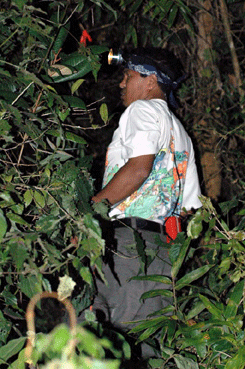
Achille looking for chameleons at night. (Photo: Daniel Grossman)
[SOUND OF RASELIMANANA INSTALLING TRAPS; FOOTSTEPS THROUGH THE FOREST]
GROSSMAN: Herpetologist Achille – who, like many Malagasy, usually goes by his first name – has dug a long line of holes in the soil of a rainforest. It took him two bone-rattling days by jeep and four hours on foot to get here, a remote, wooded valley in northeastern Madagascar. The earth underfoot here is springy. The air has the sweet smell of freshly cut grass. Lemurs bark out calls from treetops.
[LEMURS HOWLING IN THE DISTANCE]
GROSSMAN: Achille is one of four biologists, each with a different specialty, setting traps and making observations here. He says he’s been interested in snakes and frogs since childhood.
RASELIMANANA: When I was a kid I caught grasshopper. With this grasshopper I [inaudible] and to catch frog. And then I used this frog to catch snake. And then I tried to catch the snake and then push them to vomit the frog. And sometimes it is still alive. So, even when I was a kid I already love animals.
GROSSMAN: Decades and a doctorate in biology later, the researcher now gets paid to catch the slimy and slithering.
RASELIMANANA: What we would like to do is do a biological inventory. We would like to know what kind of animals live in this area, and what kind of distribution.
GROSSMAN: The Malagasy scientist shoves a plastic bucket into each hole, flush with the ground. A waist-high fence of plastic nailed to wooden stakes will funnel snake-like skinks, insects, rodents and other small animals into the containers. Once inside, the animals will be kept from escaping by the bucket’s slick sides.
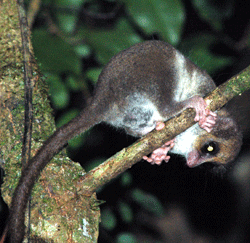
One of the rarest mammals in the world—a hairy-eared dwarf lemur. (Photo: Daniel Grossman)
GROSSMAN: After two weeks at his site in northeastern Madagascar, herpetologist Achille has completed his work. The study area is no bigger than a large city park, yet the team found a wide variety of birds, bats and small insect-eating mammals. They spotted 12 species of lemurs, including a hairy-eared dwarf lemur, a raccoon-like animal with tufts of black fur sprouting from its ears. It’s considered one of the world’s rarest mammals. Achille himself found 28 species of amphibians and 33 species of reptiles, including five never before known to science: three frogs, a skink and, most exciting for him, a spiny green chameleon.
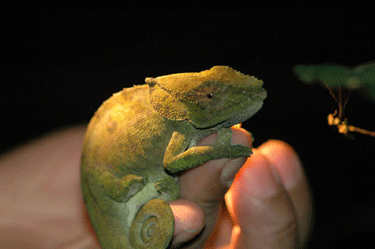
A new chameleon, discovered by Achille. (Photo: Daniel Grossman)
RASELIMANANA: To find a chameleon like this is very exciting. That’s the reason I’m always in the forest when I have time.
[FOREST SOUNDS]
[MUSIC: Carsten Nicolai & Ryiuchi Sakamoto “Duoon” from ‘Hacca Note’ (Sound Noise Music – 2003)]
CURWOOD: Just ahead: working to protect forests like these by helping farmers find less destructive ways of feeding their families. Keep listening to Living on Earth.
ANNOUNCER: Support for NPR comes from NPR stations, and: The Charles Stewart Mott Foundation, online at m-o-t-t dot org, supporting efforts to promote a just, equitable and sustainable society; The Kresge Foundation. Building the capacity of nonprofit organizations through challenge grants since 1924. On the web at k-r-e-s-g-e dot org; The Annenberg Fund for excellence in communications and education; and, The W-K Kellogg Foundation. ‘From Vision to Innovative Impact: 75 Years of Philanthropy; This is N-P-R, National Public Radio.
[MUSIC: Live Drum Music from Madagascar recorded by Daniel Grossman (2004)]
CURWOOD: It’s Living on Earth, I’m Steve Curwood. Daniel Grossman’s report on the fantastic forests of Madagascar continues now in a tiny town on the outskirts of the jungle where scientists and farmers are developing new methods to preserve the island’s ecosystem.
[A CAPELLA FOLK SINGING]
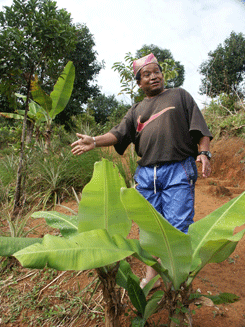
Claude stands in front of his experimental plot. (Photo: Daniel Grossman)
[SINGING]
GROSSMAN: Members of a farmers’ cooperative, they’re relaxing after nutrition workshop in a mountainous region in southern Madagascar. In a room nearby, Claude Ranaivojaona, whose wife ran the session, worries about a different sort of disaster, this one caused by people.
[SPEAKING IN MALAGAY; TRANSLATOR SPEAKING IN ENGLISH]
RANAIVOJAONA: When I was young, from here in our house we could hear the lemurs crying and making noises. Now it is very quiet. Before, the mountains were covered in forests, and, because of that, there was an abundance of water. There were a lot of springs surrounding the town, there were hundreds of small springs. But now most of those springs are dried out.
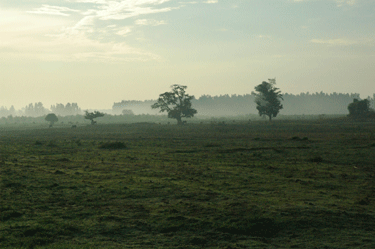
The highlands of madagascar. (Photo: Daniel Grossman)
GROSSMAN: Claude’s hamlet, Manampatrana, is in the middle of what was once a 60-mile-wide band of Madagascar’s lushest forests, running the entire length of the island’s east coast. Now, apart from the very tops of the mountains and patches here and there, nearly the whole region has been cleared for subsistence crops. In the past, many people here profited from cash crops. But one left a bitter taste in the mouths of growers such as Claude.
RANAIVOJAONA: There was a time when coffee cost 26 Ari Ari a kilo. People were able to sell coffee and buy sugar, salt, rice and even sardines.
GROSSMAN: Villagers tended saplings for years before any of the fragrant beans were ready for market. When the trees were finally mature, the efforts initially paid off. Some farmers even replaced their thatch roofs with tin for the first time. Then the coffee market collapsed. A decade later coffee prices are still depressed, and many of the tin roofs here are rusting. Despite recent signs of a recovery, Claude says growing coffee is too risky for most people here.
RANAIVOJAONA: Today it’s one price. In 15 days it’s another. A month later it’s another. And, because of this constant fluctuation in price, they are no longer secure, and so they constantly go to the forest to find quick money. Because through the forest you can always get quick money to survive day-by-day.
GROSSMAN: Claude hopes to save the remaining forest by making cultivated plots more profitable and productive for longer.
[WATERFALL FLOWING; FOOTFALLS]
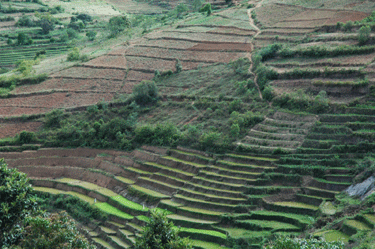
Rice paddies of Madgascar. (Photo: Daniel Grossman)
GROSSMAN: Wearing a brimless straw hat in the gathering heat of the day, the Malagasy farmer walks briskly up a precipitous footpath. He passes men and women tending plots as steeply sloped as a Swiss chalet’s roof. Unlike rice paddies on the valley bottom, when these fields are planted with crops such as rice they’re at risk of losing their soil to erosion from tropical downpours.
RANAIVOJAONA: So what we see here is my plot, where I’ve planted pineapple and banana.
GROSSMAN: Claude stops and motions majestically to a small plot of waist-high plants. In contrast to hillside rice and other annual crops planted on most of this valley’s slopes, perennial crops like these don’t get pulled up every year.
RANAIVOJAONA: It is better to plant fruit. Fruit trees. Because fruit trees, the fruit is above ground and can be harvested above ground. If you plant plants that are tubers, and whose produce is under the ground, that creates holes underneath the soil which water can easily seep into, and the soil becomes more vulnerable and can be washed away.
GROSSMAN: Claude says, planted in rice, this plot’s soil would be washed away in a matter of years. Planted in tree crops like bananas, pineapples, and leeche nuts, it could keep on producing virtually forever. Income from harvesting such fruit and nut orchards will pay for staples like rice Claude would otherwise grow himself. The long-lived trees will continue earning him money, like a retirement account, even when he’s too old to work. The tiny plot is the sort of highly productive style of farming conservationists want to see more of. They say less productive practices in widespread use, like hillside rice growing, have been fostered by decisions made far away with no regard for the farmers or forests of Madagascar.
FREUDENBERGER: What we’re seeing today is the ecological impact of the incorporation of Madagascar into the international economy.
GROSSMAN: Nevertheless, USAID expert Mark Freudenberger says he thinks the global trade in agricultural products could be harnessed to help farmers to preserve the forest, rather than force them to clear it.
FREUDENBERGER: So what we’re doing now in Madagascar is focusing much more on how to create market incentives for practicing sustainable agriculture. We’re working on increasing prices. We’re working on increasing transport infrastructures so that transport costs come down, and, hence, are more of an incentive of getting agricultural produce to the markets.
GROSSMAN: Freudenberger advises farmers to plant a diverse suite of fruit and nut trees which, like an investment portfolio containing different stocks, will help them weather the financial blow when any single crop’s boom goes bust. He says Claude’s orchard is attracting the interest of other farmers, who are gradually beginning to plant their own trees. But he says the future of the little remaining rain forest in this mountainous region is still uncertain. For instance, a train line critical for shipping farm products is in danger of shutting down.
Many conservation specialists are also promoting ecotourism as a relatively benign source of desperately needed cash for Madagascar. Visits by foreigners, who pay park fees and spend money on lodging, food and supplies in villages near reserves, are on the rise. Madagascar has also recently become more open to outsiders offering assistance. Biologist Steve Goodman says for the first time in decades there’s hope for the people and wildlife of Madagascar. Goodman won a MacArthur Genius Award for his research in the country’s forests.
GROSSMAN: This is the first time in decades where there’s really hope something is actually going to happen and things are going to move in the right direction. Both for the people of Madagascar and for the unique patrimony that this island guards.
[BOYS SINGING IN ANTANANARIVO; DRUMMING]
GROSSMAN: On a pedestrian walkway in downtown Antananarivo, the Malagasy capital, two barefoot boys sing of Jesus for tips. Believers must not be tempted by material things, they chant, and he’ll return.
[SINGING CONTINUES]
GROSSMAN: The boys may not know it, but, ever since settlers arrived here, the primary source of material goods has been the forests. But now the well is almost dry. Like these chants of spiritual salvation, many biologists are warning that salvation of the forests will require a dramatic change of heart. Madagascar’s primeval habitats must no longer be seen as a source of land and lumber, but as the Ark for preserving one of evolution’s most precious gems. Lemur expert Alison Jolly:
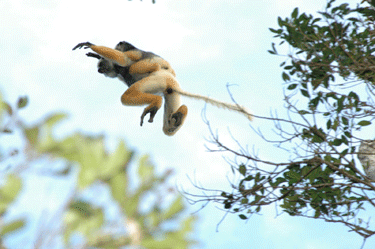
Lemur with baby on its back. (Photo: Daniel Grossman)
JOLLY: All wild species, and, above all, all wild ecosystems, are treasures. We don’t know what economic treasures there are going to be. We could guess. But they are human treasures. They are treasures of climate, of watershed, of wonder, of awe, of understanding. For understanding ourselves, our own history from the lemurs. For understanding how an ecosystem fits together. We have no idea how this will expand into some renaissance of understanding nature and understanding our place in the world. The best we can do is just keep it.
[DRUMMING AND SINGING]
GROSSMAN: For Living on Earth, this is Daniel Grossman
CURWOOD: Our story on Madagascar’s forests was originally produced for Radio Netherlands. Production assistance from Cambridge Consulting - providing management, strategy and organizational development consulting for nonprofits and foundations. To see some lovely photos of Madagascar’s wildlife - go to Living on Earth dot org and check out Daniel Grossman's award-winning website, "Fantastic Forests."
Related links:
- “Fantastic Forests” – Daniel Grossman’s award-winning website
- Video of a new chameleon
[LETTERS THEME]
Listener Letters
CURWOOD: Time now for comments from you, our listeners.
[LETTERS THEME]
CURWOOD: After our report about proposed changes at the National Parks Service, some listeners thought a shift in emphasis from conservation, to conservation and public enjoyment, could mean increased noise and pollution. Carol Hinkley Thompson, a listener in Lubbock, TX also called in to say the parks can save money by making better use of volunteers. She opposes the notion of raising funds by putting brand names on park structures.
THOMPSON: If the director is really wanting to raise money, no commercialism is needed. There are plenty of excellent ways to bring in contributions, give recognition to the donors and maintain our park service as it has been.
CURWOOD: Democratic Senator Byron Dorgan’s call to tax the so-called windfall profits of oil companies struck a nerve with John Felmy, the chief economist of the American Petroleum Institute, who says such a tax would be unfair to the millions of Americans who invest in oil companies.
FELMY: Make no mistake: a windfall profits tax would be a blow to the nation’s energy security. It would cut U.S. oil production and drive up oil imports. That’s exactly what happened the last time we had a windfall profits tax. Moreover, oil and natural gas companies already pay huge taxes. And most of what they earn goes to covering the cost of operations and to support investment in new oil and gas production.
CURWOOD: Seventeen year old Kathy Jetnil listens to our show on KIPO in Hawaii. Her family hails from the Marshall Islands and she e-mailed us after hearing our story about the legacy of displacement and illness caused by U.S. nuclear testing on the Islands a half-century ago.
“I grew up hearing stories about the nuclear testing that took away so many of my relatives, including my grandparents, who died before I was born,” writes Ms. Jetnil. “It is a vital part of our history, something we never forget. I just wanted to thank you so much for such an excellent program that brought attention to a subject virtually unknown by the public.”
And finally, some listeners went, shall we say, ape over our story about plans for a refuge for bonobos in Africa. Something about these primates’ peace-loving, matriarchal society touched quite a few of you, including Joan Qualiardi, who listens on WBEZ in Chicago.
“Having struggled through many years in our society as a single mom and grandmom, the report made me smile,” Ms. Qualiardi writes. “I’m emailing it to my granddaughters.”
If something you hear on our program makes you smile, or frown, call our listener line anytime at 800-218-9988. That's 800-218-99-88. Or write to 20 Holland Street, Somerville, Massachusetts, 02144. Our e-mail address is letters at loe dot org. Once again, letters at loe dot org. And visit our web page at Living on Earth dot org. That's Living on Earth dot o-r-g. CD's and transcripts are fifteen dollars.
2005 Best Reading
CURWOOD: So, if you are scratching your head about what to get friends and family as the holidays roll around, take a moment to listen to Bruce Barcott. Bruce reviews books for Outside magazine. Here’s his list of favorites of 2005.

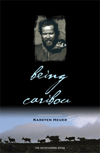
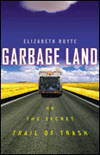
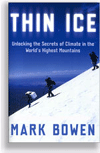
Finally, for my top book of the year, I can’t choose just one. I’ve got two. “Trawler,” by Redmond O’Hanlon, and “Collapse,” by Jared Diamond.
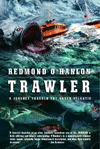
|
“Collapse” is Jared Diamond’s follow-up to his Pulitzer Prize-winning “Guns, Germs, and Steel.” Where that book explored the rise of civilizations, “Collapse” examines the spectacular fall of the ancient Maya, the Anasazi, and other once-prosperous cultures. How can we avoid their fate? By solving our environmental problems, says Diamond. The good news, he writes, is that “we are the ones in control of those problems, and we can choose or not choose to start solving them.” Next year I’m hoping to read a great book about those solutions. CURWOOD: Bruce Barcott writes for Outside magazine. Related link: [RAINFOREST NOISES; INSECTS BUZZING; BIRDS CALLING; FROGS BARKING] CURWOOD: We leave you this week in the rainforest of Madagascar. In the still of the night, frogs, owls, and lemurs were anything but quiet, as Daniel Grossman recorded their sounds in the Maratandrano Special Reserve. [EARTH EAR: “Madagascar Forest at Night” recorded by Daniel Grossman (2004)] CURWOOD: Living on Earth is produced by the World Media Foundation. Our crew includes Ashley Ahearn, Chris Ballman, Eileen Bolinsky, Ingrid Lobet, and Susan Shepherd - with help from Christopher Bolick, Kelley Cronin, James Curwood and Michelle Kweder. Our interns are Brianna Asbury, Kevin Friedl and Emily Torgrimson. Our technical director is Dennis Foley. Alison Dean composed our themes. You can find us at LOE dot org. I'm Steve Curwood. Thanks for listening. [JUNGLE CALLS CONTINUE] ANNOUNCER: Funding for Living on Earth comes from the National Science Foundation, supporting coverage of emerging science; and Stonyfield Farm. Organic yogurt, smoothies, and milk. Ten percent of profits are donated to efforts that help protect and restore the earth. Details at Stonyfield dot com. Support also comes from NPR member stations, the Ford Foundation, the Town Creek Foundation, and the Saunders Hotel Group of Boston's Lennox and Copley Square Hotels. Serving you and the environment while helping preserve the past and protect the future, 800-225-7676. NRP ANNOUNCER: This is NPR. National Public Radio. Living on Earth wants to hear from you!Living on Earth Newsletter [Click here]
Donate to Living on Earth! NewsletterLiving on Earth offers a weekly delivery of the show's rundown to your mailbox. Sign up for our newsletter today!
|






